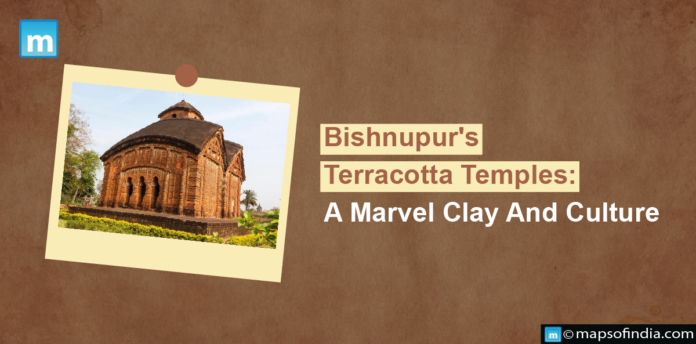Bishnupur is a tiny town in West Bengal’s Bankura district. It is famous for its magnificent terracotta temples erected by Malla monarchs in the 17th and 18th centuries. The Malla monarchs were art and culture benefactors, and their terracotta temples are evidence of their aesthetic and cultural triumphs.
The Terracotta Temples of Bishnupur
Bishnupur has around 100 clay temples. Among the most prominent temples are:
Rasmancha: King Raghunath Singh created the Rasmancha, a vast terracotta platform, in 1650. It is utilised to stage Raslila’s performances of classic dance dramas depicting Radha and Krishna’s love story.
Jor Bangla shrine: Built in 1655 by King Bir Singh II, the Jor Bangla Temple is a double-roofed terracotta shrine. It honours the Hindu deities, Krishna and Radha
Shyam Rai shrine: Built in 1643 by King Raghunath Singh, the Shyam Rai Temple is a terracotta shrine. It is named after the Hindu god Lord Krishna.
Radha Shyam shrine: Built in 1649 by King Bir Singh II, the Radha Shyam Temple is a terracotta shrine. It honours the Hindu deities, Krishna and Radha.
Madan Mohan Temple: Built in 1694 by King Bir Hambir, the Madan Mohan Temple is a terracotta temple. It is named after the Hindu god Lord Krishna.
Architecture and Design
Bishnupur’s terracotta temples are famous for their complex and artistic patterns. They are composed of burnt bricks and terracotta and are embellished with sculptures and reliefs. The sculptures show various subjects, including Hindu deities, mythological settings, and everyday life.
The temples are also notable for their distinctive architectural elements. Many temples have many roofs and are frequently embellished with terracotta towers and pinnacles. The temples are particularly famous for their large courtyards, frequently used for religious and cultural festivities.
Architectural aspects of Bishnupur’s terracotta temples
Many temples feature numerous roofs, frequently organized in a pyramidal pattern. The multiple roofs add to the temples’ grandeur and majesty. Terracotta towers and pinnacles: Terracotta towers and pinnacles are frequently used to embellish temples, giving them a distinct appearance. Sculptures and reliefs are frequently used to embellish the towers and pinnacles. Temples are notable for their vast courtyards, frequently used for religious and cultural gatherings. Courtyards are often flanked by arcades and verandas that offer shade from the sun and rain.
Cultural Significance
Bishnupur’s terracotta temples are culturally significant for a variety of reasons. They are a monument to Bishnupur and the Malla rulers’ rich cultural history. The Malla kings were patrons of art and culture, and their creative and cultural achievements are reflected in the clay temples.
The Bishnupur terracotta temples are central pilgrimage locations for Hindus across India. The temples are dedicated to Hindu deities such as Lord Krishna, Radha, and Shiva. Hindus from India travel to Bishnupur to worship at the terracotta temples and seek the deities’ blessings. These are also a source of pride for the locals. The temples represent the town’s rich cultural legacy and serve as a source of inspiration for the locals.




